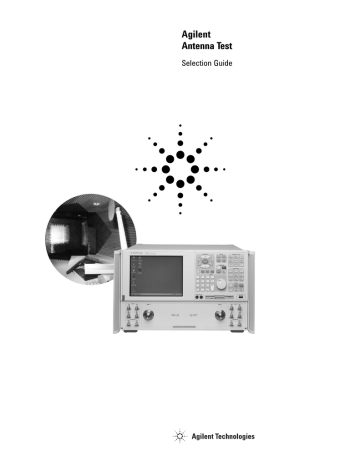- No category

advertisement

Multiple-channel measurements
Figure 33. 2 and 4-port PIN switches
85331B 1P2T PIN switch (0.045 to 50 GHz)
85332B 1P4T PIN switch (0.045 to 50 GHz)
Note
The 85331B and 85332B do not contain a switch control unit. If your system is configured with an 85330A multiple channel controller, the switch control unit must be ordered separately
(Agilent part number 85331-60061).
The 85331B and 85332B PIN switches offer the ability to switch between test channels quickly. These high-performance PIN switches have 90 dB of isolation, low loss, and a
45 MHz to 50 GHz bandwidth. They are absorptive, providing a good impedance match, which is key to achieving accurate measurements. The switches are small in size and weather resistant. Figure 34 shows a typical configuration with the PIN switches connected to the source antenna and AUT.
Customer supplied
V
Source antenna
Antenna under test
Switch control unit
H
1P2T
PIN switch
1P4T
PIN switch
Switch control unit
From transmit source
To receiver
Figure 34. A typical multiple-channel, multiple-frequency system configuration.
Customer supplied
52
Application flexibility
Far-field antenna measurements
These products are ideally suited for antennas with multiple test ports, or applications that require measuring the co- and cross-polarization response. One PIN switch can switch transmit polarization, and a second PIN switch can switch between the separate test ports of the antenna. With this technique, the co- and cross-polarization response of each test port can be measured in one rotation of the antenna.
Near-field antenna measurements
For near-field applications, both the co- and cross-polarized response of an antenna can be measured at multiple frequencies in a single scan across the antenna. For the dual polarized response, a PIN switch can be used to rapidly switch between the two probe polarizations.
Radar cross-section measurements
For Radar cross-section (RCS) applications, the ability to rapidly switch transmit and receive polarization allows full polarimetric RCS measurements to be made quickly and easily.
Complex switch configurations
Complex PIN switch trees with multiple outputs can be easily configured. Figure 35 shows conceptually how multiple PIN switches can be configured. Configurations such as these are used in making phased-array antenna measurements.
Figure 35. Example 1P16T switch configuration constructed from modular components
53
54
Switch specifications
Table 13. 85331/32B specifications
Model number
85331B
1P2T
85332B
1P4T
Frequency ON S21 OFF S21 OFF S22 ON S22 ON S11 Max power range (GHz) (db) (db) (db) (db) (db) (dBm)
0.045 to 0.5
–2.0
0.5 to 18 –4.5
18 to 26.5
26.5 to 40
–6.0
–10.0
–85
–90
–90
–85
–19.0
–19.0
–12.5
–10.0
–10.0
–10.0
–6.0
–6.0
–10.0
+27
–10.0
+27
–5.5
–4.5
+27
+27
0.045 to 0.5
–2.0
0.5 to 18 –4.5
18 to 26.5
26.5 to 40
–7.0
–12.0
–85
–90
–90
–85
–19.0
–19.0
–12.5
–10.0
–9.0
–9.0
–5.0
–4.5
–10.0
+27
–10.0
+27
–5.5
–4.0
+27
+27
On S11
On S21
Off S21
On
Off
Off
Off
On S22
Off S22
Figure 36. Switch port match definitions for switch on/off states
Other information
Connectors on PIN switch
All RF ports are 2.4 mm female (a 2.4 mm male to 3.5 mm female adapter is provided for all RF ports). The bias connector mates with LEMO 7 pin plug #FGG.1K.307.CLAC60.
Drive levels
Refer to Figure 37 for pin locations. Note the notch and red mark on the bias connector outer ring are used for reference.
To turn ON a port, supply a –7VDC (± 0.35V) bias voltage. Current is approximately 41 mA.
To turn OFF a port, supply a +6.3VDC (± 0.32V) bias voltage. Current is approximately 95 mA.
Only one port can be turned on at a time, or all ports can be off.
The total current is approximately 400 mA for 85332B, 200 mA for 85331B with all ports off.
Pin 7
Pin 1 Pin 6
Pin 2
Pin 5
Pin 3 Pin 4
Note
Agilent channel partners can provide the control, interface and timing required for these
PIN switches.
Figure 37. Bias connector pin locations (enlarged)
Pin 1 = Port 1 on/off bias
Pin 2 = Port 2 on/off bias
Pin 3 = Port 3 on/off bias (not connected for 85331B)
Pin 4 = Port 4 on/off bias (not connected for 85331B)
Pin 5 = Common/ground (0VDC)
Pins 6,7 = Not Connected
Size and weight
65 mm (2.6 in) x 70 mm (2.75 in) x 70 mm (2.75 in)
Approximately 0.35 kg (0.7 lbs)
Environmental
Operating conditions
Temperature –20 to 55 °C (–4 to 131 °F)
Humidity 5 to 95% at 40 °C or less (non-condensing)
Non-operating conditions
Temperature –40 to 70 °C (–40 to 158 °F)
Humidity 5 to 95% at 65 °C or less (non-condensing)
Power
Supplied by external controller
55
advertisement
* Your assessment is very important for improving the workof artificial intelligence, which forms the content of this project
Related manuals
advertisement
Table of contents
- 3 Use this guide to
- 4 Main parts of an antenna range
- 4 Channel Partners
- 6 Near-field antenna measurements
- 7 Far-field antenna measurements
- 9 Radar cross-section measurements
- 10 Banded millimeter-wave antenna configurations
- 12 Transmit site configuration
- 17 Receive site configuration with external mixing
- 21 Determining measurement speed
- 22 Optimizing speed and dynamic range
- 23 PNA interface requirements
- 29 Triggering
- 30 Functional test
- 31 analyzer based systems
- 32 PNA series network analyzers
- 33 Migration examples
- 35 Microwave network analyzers
- 38 Sources
- 40 Frequency converters
- 50 Amplifiers
- 52 Multiple-channel measurements
- 56 Measurement automation
- 57 Terms and definitions
- 58 PNA memory
- 58 Memory clearing, sanitization and/or removal procedures
- 59 User and remote interface security measures
- 60 Procedure for declassifying a faulty instrument